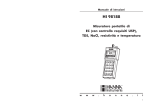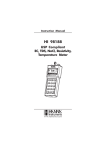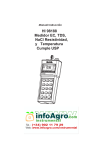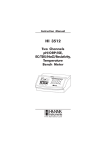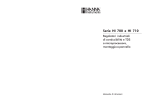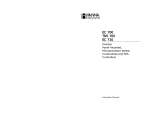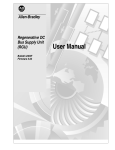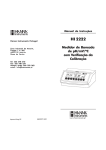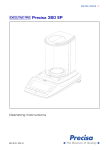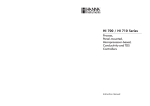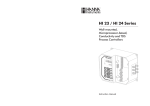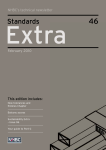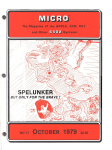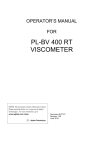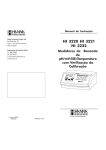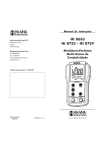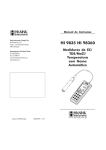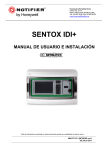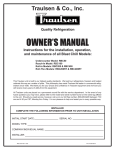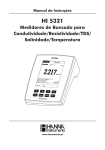Download HI 98192 - Hanna Instruments
Transcript
Instruction Manual HI 98192 USP Compliant EC, TDS, NaCl, Resistivity, Temperature Meter w w w. h a n n a i n s t . c o m 1 Dear Customer, Thank you for choosing a Hanna Instruments product. Please read this instruction manual carefully before using the instrument. This manual will provide you with the necessary information for correct use of the instrument, as well as a precise idea of its versatility. If you need additional technical information, do not hesitate to e-mail us at [email protected] or view our worldwide contact list at www.hannainst.com. WARRANTY The HI 98192 is guaranteed for two years against defects in workmanship and materials when used for their intended purpose and maintained according to instructions. Electrodes and probes are guaranteed for six months. This warranty is limited to repair or replacement free of charge. Damage due to accidents, misuse, tampering or lack of prescribed maintenance is not covered. If service is required, contact the dealer from whom you purchased the instrument. If under warranty, report the model number, date of purchase, serial number and the nature of the problem. If the repair is not covered by the warranty, you will be notified of the charges incurred. If the instrument is to be returned to Hanna Instruments, first obtain a Returned Goods Authorization number from the Technical Service department and then send it with shipping costs prepaid. When shipping any instrument, make sure it is properly packed for complete protection. All rights are reserved. Reproduction in whole or in part is prohibited without the written consent of the copyright owner, Hanna Instruments Inc., Woonsocket, Rhode Island, 02895, USA. 2 TABLE OF CONTENTS WARRANTY .......................................................................................................................... 2 PRELIMINARY EXAMINATION ................................................................................................. 3 GENERAL DESCRIPTION ......................................................................................................... 4 FUNCTIONAL DESCRIPTION ................................................................................................... 5 SPECIFICATIONS .................................................................................................................. 7 OPERATIONAL GUIDE ............................................................................................................ 9 AUTORANGING ................................................................................................................... 14 TEMPERATURE COMPENSATION ........................................................................................... 15 CONDUCTIVITY VERSUS TEMPERATURE CHART ...................................................................... 16 USP MEASUREMENT .......................................................................................................... 17 USP MODE PROCEDURES .................................................................................................... 21 USER CALIBRATION ............................................................................................................ 25 EC CALIBRATION ................................................................................................................ 26 GOOD LABORATORY PRACTICE (GLP) ..................................................................................... 33 SETUP ............................................................................................................................... 35 LOG ON DEMAND ............................................................................................................... 47 AUTOLOG ........................................................................................................................... 50 AutoEnd ............................................................................................................................ 52 TEMPERATURE CALIBRATION (for technical personnel only) .................................................... 53 PC INTERFACE .................................................................................................................... 56 BATTERIES REPLACEMENT ................................................................................................... 63 TROUBLESHOOTING GUIDE ................................................................................................. 64 PROBE MAINTENANCE ........................................................................................................ 65 ACCESSORIES .................................................................................................................... 66 PRELIMINARY EXAMINATION Remove the instrument from the packing material and examine it carefully to make sure that no damage has occurred during shipping. If there is any damage, notify your dealer or the nearest Hanna Customer Service Center. Each instrument is supplied with: • HI 763133 4-ring probe with temperature sensor (4 m cable) • HI 7031M 1413 µS/cm calibration standard (230 ml) • HI 7035M 111.8 mS/cm calibration standard (230 ml) • HI 92000 PC software • HI 920015 Micro USB cable • 100 mL Plastic Beaker (2 pcs.) • 4 x 1.5 V AA Batteries • Instruction Manual 3 • Rugged carrying case Note: Save all packing material until you are sure that the instrument functions correctly. All defective items must be returned in the original packing with the supplied accessories. GENERAL DESCRIPTION The HI 98192 instrument is state-of-the-art, heavy-duty conductivity meter, designed to provide laboratory results and accuracy under harsh industrial conditions. The USP standard compliance makes the instrument useful for pure water determination. It is provided with a series of new diagnostic features which add an entirely new dimension to the measurement of conductivity, by allowing the user to dramatically improve the reliability of the measurement: • 7 memorized standards (0.00 µS/cm, 84.0 µS/cm, 1.413 mS/cm, 5.00 mS/cm, 12.88 mS/ cm, 80.0 mS/cm and 111.8 mS/cm) for calibration. • EC calibration up to five calibration points. • Messages on the graphic LCD for an easy and accurate calibration. • Diagnostic features to alert the user when the electrode needs cleaning. • User-selectable “Outside Calibration Range” warning. • User-selectable “calibration time out” to remind when a new calibration is necessary. Moreover, they offer an extended temperature range from -20 to 120 °C (-4 to 248 °F), using temperature sensor inside EC electrode. This instrument can also measure in Resistivity, TDS and Salinity ranges. Three salinity modes are available: % NaCl, Practical salinity and Natural seawater scale. Other features include: • Temperature source selection • Temperature automatic compensation, linear or non linear user selectable • Temperature reference selection 15 °C, 20 °C or 25 °C. • Temperature coefficient set • Log on demand up to 400 samples • Auto Log feature up to 1000 records • Auto Hold feature, to freeze first stable reading on the LCD • Lock and user setup Fixed range selection • GLP feature, to view last calibration data for EC, NaCl • Probe change recognition • PC interface • Probe replatinization 4 FUNCTIONAL DESCRIPTION FRONT VIEW 1) Liquid Crystal Display (LCD). 2) F1, F2, F3 functional keys. 3) / keys to manually increase/decrease the parameters or to scroll between the parameter list. 4) ON/OFF ( ) key, to turn the instrument ON and OFF. 5) LIGHT ( ) key to toggle display backlighting. 6) GLP key, to display Good Laboratory Practice information. 7) CAL key, to enter/exit calibration mode. 8) SETUP key, to enter/exit SETUP mode. 9) RCL key, to enter/exit view logged data mode. 10) MODE key to toggle between EC, USP and Salinity ranges. 11) RANGE key, to switch between EC, Resistivity, TDS, NaCl. 12) HELP key to enter/exit contextual help. 13) ESC to leave current mode, exit calibration, setup, help. etc. 5 TOP VIEW 14) Electrode DIN connector. 15) USB connector. 6 SPECIFICATIONS Range EC Resolution Accuracy Range Resistivity Resolution Accuracy TD S Range Resolution Accuracy 0 to 400 mS/cm (shows values up to 1000 mS/cm) Actual conductivity 1000 mS/cm 0.001 to 9.999 µS/cm* 10.00 to 99.99 µS/cm 100.0 to 999.9 µS/cm 1.000 to 9.999 mS/cm 10.00 to 99.99 mS/cm 100.0 to 1000.0 mS/cm (autoranging) 0.001 µS/cm* / 0.01 µS/cm / 0.1 µS/cm 0.001 mS/cm / 0.01 mS/cm / 0.1 mS/cm ±1% of reading (±0.01 µS/cm or 1 digit whichever greater) 1.0 to 99.9 ohms 100 to 999 ohms 1.00 to 9.99 Kohms 10.0 to 99.9 Kohms 100 to 999 Kohms 1.00 to 9.99 Mohms 10.0 to 100.0 Mohms* (autoranging) 0.1 ohms / 1 ohms / 0.01 Kohms / 0.1 Kohms / 1 Kohms 0.01 Mohms / 0.1 Mohms* ±1% of reading (±10 ohms or 1 digit whichever greater) 0.00 to 99.99 ppm 100.0 to 999.9 ppm 1.000 to 9.999 g/L 10.00 to 99.99 g/L 100.0 to 400.0 g/L (autoranging) 0.01 ppm / 0.1 ppm / 0.001 g/L / 0.01 g/L / 0.1 g/L ±1% of reading (±0.05 ppm or 1 digit whichever greater) * The 0.001 µS/cm EC range and 0.1 MOhms Resistivity range are not available with the 4 m cable probe. 7 Range % NaCl: Seawater scale: Practical salinity: 0.0 to 400.0 % 0.00 to 80.00 (ppt) 0.01 to 42.00 (PSU) Salinity Resolution 0.1 % / 0.01 Accuracy ±1% of reading Range -20.0 to 120.0 °C (-4.0 to 248.0 °F) Temperature Resolution 0.1 °C (0.1 °F) Accuracy ±0.2 °C (±0.4 °F) (excluding probe error) Automatic up to five points with seven memorized standards (0.00 EC Calibration µS/cm, 8 4. 0 µ S/ cm, 1. 4 1 3 m S/ cm, 5. 0 0 m S/ cm, 1 2. 8 8 m S/ cm, 80.0 mS/cm, 111.8 mS/cm) Cell Constant Setup 0.010 to 10.000 Max. one point only in % range (with HI 7073 standard); NaCl Calibration use conductivity calibration for other ranges Implemented Standards USP compliant HI 763133 (8 pin DIN, 4m cable) EC Probe Temperature Source Automatic from sensor inside the probe; Manual entry Temperature Compensation NoTC, Linear, Non Linear ISO/DIS 7888 std Reference Temperature 15, 20, 25 °C Temperature Coeficient 0.00 to 10.00 %/°C TDS Factor 0.40 to 1.00 Log on Demand 400 samples 5, 10, 30 sec, Lot Logging 1, 2, 5, 10, 15, 30, 60, 120, 180 min (max 1000 samples) Memorized Profiles Up to 10 Measurement Modes Autorange, AutoEnd, LOCK and fixed range Battery Type / Life 4 x 1.5V AA batteries / 100h no backlight 25h with backlight Auto Power Off User selectable: 5, 10, 30, 60 minutes or disabled PC Interface Opto-isolated USB Dimensions 185 x 93 x 35.2 mm (7.3 x 3.6 x 1.4”) Weight 400 g Environment 0 to 50 °C (32 to 122 °F) max. RH 100% IP 67 8 OPERATIONAL GUIDE INITIAL PREPARATION The instrument is supplied complete with batteries. See Batteries Replacement for details, page 63. To prepare the instrument for field measurements close the serial communication socket with proper stopper (to ensure waterproof protection). Connect the EC probe to the DIN connector on the top of the instrument. Tighten the thread ring. Make sure the probe sleeve is properly inserted. Turn the instrument ON by pressing ON/OFF key. At start-up the display will show the Hanna logo for a few seconds followed by the percentage indication of the remaining battery life and the “Loading Log...” message, then enters the measurement mode. The Auto Power Off feature turns the instrument off after a set period (default 30 min) with no button pressed to save battery life. To set another period or to disable this feature, see SETUP menu on page 35. The instrument continues to monitor the inputs and memorize readings if the automatic logging is enabled and started. To stop autologging press StopLog key or simply power off the instrument by pressing the ON/OFF key. The Auto Light Off backlight feature turns the backlight off after a set period (default 1 min) with no buttons pressed. To set another period or to disable this feature, see SETUP menu on page 35. MEASUREMENTS Immerse the probe into the solution to be tested. The sleeve holes must be completely submerged. Tap the probe repeatedly to remove any air bubbles that may be trapped inside the sleeve. If needed, press RANGE repeatedly until the desired range (EC, Resistivity, TDS, Salinity) is selected on the LCD. Allow for the reading to stabilize. The main LCD line displays the measurement in the selected range, while the temperature is displayed on the lower LCD line. 9 EC range The conductivity range is from 0 to 400 mS/cm . The actual conductivity range (the uncompensated conductivity) is up to 1000 mS/cm. The instrument will display conductivity readings up to 1000 mS. Note: The symbol in front of the temperature reading means that the temperature can be entered by the user (Manual option selected in SETUP, or temperature out of range). Resistivity range The reciprocal of the conductivity of a material is the resistivity. TDS range A conductivity measured value can be corrected to a total dissolved solids value using the TDS factor. Salinity The salinity is derived from the conductivity of a sample. Salt % range The percent of salinity in a sample is dependent on the sample and the salinity coefficient. 10 For practical reasons, the salinity of a solution is derived from the salinity of the seawater. Two methods of calculating the salinity from the conductivity are supported: • Natural seawater scale • Practical salinity scale Natural seawater scale (UNESCO 1966) According to the definition, salinity of a sample in ppt is calculated using the following formula: C (sample) RT= T C(35;15)·rT rT=1.0031·10-9 T4–6.9698·10-7 T3+1.104259·10-4 T2+2.00564·10-2 T+6.766097·10-1 R=RT+10-5RT(RT–1.0)(T–15.0)[96.7-72.0RT+37.3RT2–(0.63+0.21RT2)(T–15.0)] S=-0.08996+28.2929729R+12.80832R2–10.67869R3+5.98624R4–1.32311R5 where: RT - coefficient; CT(sample) - uncompensated conductivity at T °C; C(35;15)= 42.914 mS/cm - the corresponding conductivity of KCl solution containing a mass of 32.4356 g KCl / 1 Kg solution; rT - temperature compensation polynom. Note: The formula can be applied for temperatures between 10 °C and 31 °C. To access this range press Mode while in Salinity range until the seawater scale [SW] is displayed. Practical salinity scale This is a practical scale based on the precise measurement of the electrical conductivity of a solution with a known salinity range. The relationship derived from the scale relates salinity, conductivity, temperature and pressure and use a solution with a salinity of 35 ‰ as datum point. This is taken to have a conductivity of 42.914 mS/cm of 15 °C at standard atmospheric pressure. 11 According to the definition, salinity of a sample in PSU (practical salinity units) is calculated using the following formula: RT - coefficient; CT(sample) - uncompensated conductivity at T °C; C(35,15)= 42.914 mS/cm - the corresponding conductivity of KCl solution containing a mass of 32.4356 g KCl / 1 Kg solution; rT - temperature compensation polynom a0 = 0.008 b0=0.0005 a1 = -0.1692 b1= -0.0056 a2 = 25.3851 b2= -0.0066 a3 = 14.0941 b3= -0.0375 a4 = -7.0261 b4= 0.0636 a5 = 2.7081 b5= -0.0144 c0 = 0.008 c1 = 0.0005 X = 400RT Y = 100RT f (T)= (T-15)/[1+0.0162(T-15)] Notes: • The formula can be applied for salinity values between 0 and 42 PSU. • The formula can be applied for temperatures between -2 °C and 35 °C. To reach this range press Mode while in Salinity range until the practical salinity scale [PSU] is displayed. 12 Notes: • If the meter displays the top of the range blinking, the reading is out of range. • If the stability indicator “ ” blinks, the reading is unstable. • Make sure the meter is calibrated before taking measurements. • If measurements are taken successively in different samples, for accurate readings it is recommended to rinse the probe thoroughly with deionized water before immersing it into the samples. • TDS reading is obtained by multiplying the EC reading by the TDS factor, which has a default value of 0.50. It is possible to change the TDS factor in the 0.40 to 1.00 range by entering SETUP mode. The probes designed to work with this instrument have an internal ID identification. Every time the instrument detects probe changing, it reminds the user to update the cell constant of the new probe being used and to calibrate in the appropriate EC range. 13 AUTORANGING The EC, Resistivity and TDS scales are autoranging. The meter automatically sets the scale with the highest possible resolution. By pressing Lock, the autoranging feature is disabled and the current range is frozen on the LCD. The “Range: Locked” message is displayed. To restore the autoranging option press “AutoRng” functional key again. The autoranging mode is also disabled by selecting a “fixed range” in the SETUP menu. While in fixed range mode the instrument will display the readings with the fixed resolution. A maximum of 6 digits can be displayed. The top of the fixed range is displayed blinking when the reading exceeds this value. To disable fixed range mode enter SETUP and select autoranging mode. Note: Autoranging is automatically restored if the range is changed, if the calibration mode is entered, or if the meter is turned off and back on again. 14 TEMPERATURE COMPENSATION Two selectable temparature sources are available: reading directly from the sensor inside the probe or manual entry. Three options of compensating temperature are available: Linear Temperature Compensation: The conductivity of a solution with a specific electrolyte concentration changes with temperature. The relationship of the change in conductivity as a function of temperature is described by a solution’s temperature coefficient. This coefficient varies with each solution and is user selectable (see SETUP mode). Non Linear Temperature Compensation: for natural water measurements. The conductivity of natural water shows strong non-linear temperature behavior. A polynomial relationship is used to improve the accuracy of the calculated results. Note: Conductivity measurements of natural water can only be performed at temperatures ranging from 0 to 36 °C. Otherwise the “Out T range” message will be displayed blinking. No Temperature Compensation (No TC): The temperature shown on the LCD is not taken into account. To select the desired option enter Setup menu (see page 35). If the temperature is out of the -20 °C - 120 °C range the instrument will do no temperature compensation. 15 CONDUCTIVITY VERSUS TEMPERATURE CHART The conductivity of an aqueous solution is the measure of its ability to carry an electrical current by means of ionic motion. The conductivity invariably increases with increasing temperature. It is affected by the type and number of ions in the solution and by the viscosity of the solution itself. Both parameters are temperature dependent. The dependency of conductivity on temperature is expressed as a relative change per Celsius degree at a particular temperature, commonly as percent per °C. The following table lists the temperature dependence of the HANNA calibration buffers. °C °F 0 5 10 15 16 17 18 19 20 21 22 23 24 25 26 27 28 29 30 31 32 41 50 59 60.8 62.6 64.4 66.2 68 69.8 71.6 73.4 75.2 77 78.8 80.6 82.4 84.2 86 87.8 HI7030 HI7031 HI8030 HI8031 (µS/cm) (µS/cm) 7150 8220 9330 10480 10720 10950 11190 11430 11670 11910 12150 12390 12640 12880 13130 13370 13620 13870 14120 14370 776 896 1020 1147 1173 1199 1225 1251 1278 1305 1332 1359 1386 1413 1440 1467 1494 1521 1548 1575 HI7033 HI8033 (µS/cm) HI7034 HI8034 (µS/cm) HI7035 HI8035 (µS/cm) HI7039 HI8039 (µS/cm) 64 65 67 68 70 71 73 74 76 78 79 81 82 84 86 87 89 90 92 94 48300 53500 59600 65400 67200 68500 69800 71300 72400 74000 75200 76500 78300 80000 81300 83000 84900 86300 88200 90000 65400 74100 83200 92500 94400 96300 98200 100200 102100 104000 105900 107900 109800 111800 113800 115700 117700 119700 121800 123900 2760 3180 3615 4063 4155 4245 4337 4429 4523 4617 4711 4805 4902 5000 5096 5190 5286 5383 5479 5575 16 USP MEASUREMENT Pharmaceutical laboratories working in the US market are obliged to respect the regulations set down th by the US Pharmacopoeia (USP). The 5 supplement of USP24-NF19 lays down the rules for checking the quality of pure or fully deionized water used for the production of injection products. The conductivity of water provides information on its chemical composition. It is therefore logical that conductivity is the main parameter to measure. The conductivity of water is a measure of the ion mobility through this water. The conductivity partly depends on the pH, the temperature and the amount of atmospheric carbon dioxide, which has been dissolved in water to form ions (intrinsic conductivity). The conductivity also depends on the chloride, sodium and ammonium ions initially present in water (extraneous conductivity). The conductivity (intrinsic and extraneous) of the water is measured at Stage 1 and compared to values listed in a table to evaluate if the studied water is suitable or not for use in pharmaceutical applications. If the sample fails Stage 1, additional tests have to be performed (Stage 2 and 3) in order to determine if the excessive conductivity value is due to intrinsic factors or extraneous ions. USP Requirements Automatic temperature correction must not be used. Instrument specifications Minimum resolution of 0.1 µS/cm on the lowest range. Excluding the cell accuracy, the instrument accuracy must be ±0.1 µS/cm. Meter calibration It is accomplished by replacing the conductivity cell with precision resolution traceable to primary standards (accurate to ±0.1 % of the stated value) or an equivalently accurate resistance device. Cell calibration Meter conductivity must be measured accurately using calibrated instrumentation. The conductivity cell constant must be known in ± 2 %. Before starting water analysis calibrate in the lowest EC range or set the probe cell constant (enter the value written in the calibration certificate delivered with the probe). Stage 1 Determine the temperature and conductivity of the water. • Rinse the probe carefully with deionized water. Check that the 4 rings, sleeve holes and the temperature sensor are immersed in the sample and that no air bubbles are trapped. Connect the probe to the meter, enter USP mode and press the Stage 1 key. The instrument will perform a temperature and conductivity measurement (using a non-temperature corrected conductivity reading). 17 • Using the Stage 1 temperature and conductivity requirement table the corresponding conductivity limit at that temperature is determined. • If the measured conductivity is not greater than the table value the water meets the requirements of the test for conductivity. If the conductivity is higher than the table value, proceed with Stage 2. Stage 1 table Temperature and conductivity requirements * (for the non-temperature compensated conductivity measurements only) (*) Values from USP - NF Fifth Supplement Temperature °C Conductivity µS/cm 0 0.6 5 0.8 10 0.9 15 1.0 20 1.1 25 1.3 30 1.4 35 1.5 40 1.7 45 1.8 50 1.9 55 2.1 60 2.2 65 2.4 70 2.5 75 2.7 80 2.7 85 2.7 90 2.7 95 2.9 100 3.1 Physical Tests / Water Conductivity (645) 3465-3467 18 Stage 2 Determine the influence of CO2. Note: Stability criteria <0.5 %/min corresponds in fact to a change in conductivity <0.02 µS/cm per minute (equivalent to 0.1 mS/cm per 5 minutes), as required in the Stage 2 USP document. • Transfer a sufficient amount of water (100 mL or more) to a thermostatic vessel, and stir the test specimen. Adjust the temperature and maintain it at 25 ±1 °C. We recommend using a thermostatic bath. • Rinse the cell carefully with deionized water. Place the conductivity probe in the sample and dip it in the thermostatic vessel containing the sample. Check that the 4 rings and sleeve holes are immersed in the solution. • Press Step 2. • When the conductivity value is stable, if the conductivity is not greater than 2.1 µS/cm the water meets the requirements of the test, for conductivity. If the conductivity is greater than 2.1 µS/cm proceed with Stage 3. Stage 3 Determine the combined effect of the CO2 and pH. Use a Hanna Instruments pH meter. Take care that the instrument is calibrated in at least two points using pH 4.01 and pH 7.01 Hanna buffers. Perform the following test within approximately 5 minutes of the conductivity determination while maintaining the sample temperature at 25±1 °C. • Add the Saturated KCl Solution to the sample (0.3 mL per 100 mL of the test specimen), and determine the pH to the nearest 0.1 pH unit. • Press Stage 3 key, then enter the corresponding pH reading. • Referring to the Stage 3 pH and conductivity requirement table the instrument determines the conductivity limit at the measured pH value. If the measured conductivity is no greater than the conductivity requirements for the pH determined the water meets the requirements of the test for conductivity. If the measured conductivity is greater than this value or the pH is outside of the range of 5.0 to 7.0, the water does not meet the requirements of the test for conductivity. 19 Stage 3 pH and conductivity requirements (For atmosphere and temperature equilibrated samples only) pH Conduct ivit y µS/cm 5.0 4.7 5.1 4.1 5.2 3.6 5.3 3.3 5.4 3.0 5.5 2.8 5.6 2.6 5.7 2.5 5.8 2.4 5.9 2.4 6.0 2.4 6.1 2.4 6.2 2.5 6.3 2.4 6.4 2.3 6.5 2.2 6.6 2.1 6.7 2.6 6.8 3.1 6.9 3.8 7.0 4.6 20 USP MODE PROCEDURES Press Mode key while in EC range to enter USP mode. The instrument will display USP on the main screen. Press Stage 1 to start with first stage evaluation. Press Stage 2 to start with second stage evaluation. If Stage 1 is pressed a tutorial screen is displayed. Use the Arrow keys to scroll the tutorial message. Press Continue to skip the tutorial message and enter EC measuring mode. If the temperature source is manual entry, press USP Fact. to select USP factor to be changed (the is displayed before the 100% value). To increase the accuracy of the analysis decrease the USP factor value. Wait until reading is stable. If the sample reading meets the USP Stage 1 criteria, the “USP Met” message will be displayed. Press Report to view report. 21 Press Log to store USP Stage 1 report. The report number and the amount of free log space in % is displayed for several seconds. Note: If the log space is full enter view logged data mode by pressing RCL key and free log space by deleting previously stored records. If the sample reading didn’t meet the USP Stage 1 criteria, the “USP Not Met” message is displayed. Press ESC to return to the USP main screen. Press Report to view USP report. Press Log to store the Stage 1 report. Press Stage 2 to enter USP Stage 2 mode. The USP Stage 2 tutorial screen is displayed. Use the Arrow keys to scroll the tutorial message. Press Continue to skip the tutorial message and enter USP Stage 2 measuring mode. 22 Wait until the reading is stable (about 5 minutes). Note: If the input record has an instability higher than 1 mS, stability period will be reset. The completion time bar will remain empty. The “USP Met” message will be displayed if the USP Stage 2 criteria is reached. Press Report to view the USP report. Press key to scroll the report screens. Press Log to store report. Notes:• The report number will be the same as at the Stage 1 report (informations of the same analysis). • If the log space is full enter view logged data mode by pressing RCL key and free log space by deleting previously stored records. The “USP Not Met” message is displayed if the USP Stage 2 criteria is not met. Press Report to view report. Press key to scroll the report screens. Press Log to store report. Press Stage 3 to enter in Stage 3 water analysis. The USP Stage 3 tutorial is displayed. 23 Press Continue to enter USP Stage 3 analysis. The instrument will display the sample pH setting mode. Use a calibrated pH meter to read the pH value of the sample. Use ARROW keys to set the value to that displayed on the pH meter. Press Accept to confirm the pH setting. The USP Stage 3 report will be displayed. The report will include all stages information. Press key to scroll the report pages . Press Log to store the report. Press ESC to return to USP main screen. Notes:• The Stage 3 report will include the information about Stage 1 and Stage 2. • If the log space is full enter view logged data mode by pressing RCL key and free log space by deleting previously stored records. 24 USER CALIBRATION To enter User Calibration screen press CAL key while in EC or Salinity range. From EC range Press the corresponding functional key to enter: • EC user calibration. • Probe replatinization. • Temperature user calibration. From Salinity % range Press the corresponding functional key to enter: • Salinity % user calibration. • Temperature user calibration. 25 EC CALIBRATION It is recommended to calibrate the instrument frequently, especially if high accuracy is required. The EC range should be recalibrated: • Whenever the EC electrode is replaced. • At least once a week. • Before USP measurement. • After testing aggressive chemicals. • When calibration alarm time out is expired - “CAL DUE” blinks (if feature is enabled in SETUP). • If “Outside Cal Range” message blinks during EC measurement (the measurement range is not covered by current calibration, if feature is enabled in SETUP). Note: TDS and Resistivity readings are automatically derived from the EC reading and no specific calibration is needed. PROCEDURE HI 98192 instrument offers a choice of 7 memorized standards (0.00 µS/cm, 84.0 µS/cm, 1.413 mS/cm, 5.00 mS/cm, 12.88 mS/cm, 80.0 mS/cm and 111.8 mS/cm). For accurate EC measurements, it is recommended to perform a calibration in maximum allowed points. However, at least a two point calibration is suggested (offset calibration in 0.00 µS and one in any other calibration standard). The instrument will automatically recognize the standards and skip the standard used during calibration. • If a five point calibration is performed, one of the points must be 0.0 µS (offset). • Pour small quantities of selected standard solutions into clean beakers. For accurate calibration use two beakers for each standard solution, the first one for rinsing the electrode and the second one for calibration. • Remove the protective cap and rinse the electrode with some of the standard solution to be used for the first calibration point. FIVE POINT CALIBRATION • • • • It is recommended to perform the first point calibration as offset calibration. Tap the probe repeatedly to remove any air bubbles that may be trapped inside the sleeve. For offset (zero) calibration, just leave the dry probe in the air. From EC range press CAL to enter calibration screen. 26 • Leave the probe in the air and press EC. The instrument will display the measured EC on the LCD, first expected standard and the temperature reading. • If necessary, press the ARROW keys to select a different standard value. • The “ ” tag will blink on the LCD until the reading is stable. • When the reading is stable and within range of the selected buffer, CFM functional key is displayed. • Press CFM to confirm first point. • The calibrated value and the second expected standard value is then displayed on the LCD. • After the first calibration point is confirmed, immerse the EC electrode into the second standard solution and stir gently. Tap the probe repeatedly to remove any air bubbles that may be trapped inside the sleeve. The instrument will automatically detect the standard after several seconds. • If necessary, press the ARROW keys to select a different standard value. • The “ ” tag will blink on the LCD. • When the reading is stable and within range of the selected standard, the CFM functional key is displayed. 27 • Press CFM to confirm calibration. • The calibrated value and the third expected standard value will be displayed. • After the second calibration point is confirmed, immerse the EC electrode into the third standard solution and stir gently. Tap the probe repeatedly to remove any air bubbles that may be trapped inside the sleeve. The instrument will automatically detect the standard value. • If necessary, press the ARROW keys to select a different standard value. • The “ ” tag will blink on the LCD until the reading is stable. • When the reading is stable and within range of the selected standard, the CFM functional key is displayed. • Press CFM to confirm calibration. • The calibrated value and the fourth expected standard value will be displayed. 28 • After the third calibration point is confirmed, immerse the EC electrode into the fourth standard solution and stir gently. Tap the probe repeatedly to remove any air bubbles that may be trapped inside the sleeve. • The instrument will automatically detect the standard value. • If necessary, press the ARROW keys to select a different standard value. • The “ ” tag will blink on the LCD until the reading is stable. • When the reading is stable and within range of the selected standard, the CFM functional key is displayed. • Press CFM to confirm calibration. • The calibrated value and the fourth expected standard will be displayed. • After the fourth calibration point is confirmed, immerse the EC electrode into the fifth standard solution and stir gently. 29 • If necessary, press the ARROW keys to select a different standard value. • The “ ” tag will blink on the LCD until the reading is stable. • When the reading is stable and within range of the selected standard, the CFM functional key is displayed. • Press CFM to confirm calibration. • The instrument stores the calibration values and returns to normal measurement mode. FOUR, THREE or TWO POINT CALIBRATION • Proceed as described in “FIVE POINT CALIBRATION” section. • Press CAL or ESC after the appropriate accepted calibration point. The instruments will return to measurement mode and will store the calibration data. ERROR SCREENS Wrong standard The calibration cannot be confirmed. The EC reading is not within range of the selected standard. Select another standard using the ARROW keys. CLEAR CALIBRATION Press Clear functional key when displayed to clear old calibrations. All old calibrations will then be cleared and the instrument continues calibration. The points confirmed in current calibration are kept. Note: If Clear calibration is invoked during the first calibration point, the instrument returns to measurement mode. 30 REPLACE CALIBRATION STANDARD Each time a standard is confirmed the new calibration parameters replace the old calibration parameters of the corresponding standard. If the current standard has no correspondence in the existing stored calibration structure and this is not full, the current standard is added to the existing stored calibration (up to 5 standards). If the existing stored calibration is full (five calibration points) after confirming the calibration point, the instrument will ask which buffer will be replaced by current standard. Press ARROW keys to select another standard to be replaced. Press CFM to confirm the standard that will be replaced. Press CAL or ESC to leave replace mode. In this case, the standard will not be stored. Note: The replaced standard is not removed from calibration list and it can be selected for the next calibration points. NaCl CALIBRATION NaCl calibration is a one point procedure in 100.0% NaCl solution. Use the HI 7037L calibration solution (seawater solution) as a 100% NaCl standard solution. • To enter NaCl calibration select the Salinity % range and press CAL. • The instrument enters the Salinity calibration screen. • Press Salt. The measured % NaCl, the temperature and the 100% NaCl standard are displayed. • Rinse the probe with some of the calibration solution or deionized water. Immerse the probe into HI 7037L solution. Tap the probe repeatedly to remove any air bubbles that may be trapped inside the sleeve. • The “ ” tag will blink on the LCD until the reading is stable. • When the reading is stable, the CFM functional key is displayed. 31 Press CFM to confirm calibration. • The instrument returns to measurement mode. Notes: • If the uncalibrated reading is too far from the expected value, calibration is not recognized. The “Wrong” message will be displayed. • The meter uses 1.90 %/°C temperature compensation factor during calibration. If the “Temperature Coef” in the SETUP menu has been set to a different value, when exiting calibration mode, the displayed value might be different from the nominal standard value. 32 GOOD LABORATORY PRACTICE (GLP) GLP is a set of functions that allows storage and retrieval of data regarding the maintenance and status of the electrode. All data regarding EC and NaCl calibration is stored for the user to review when necessary. EXPIRED CALIBRATION The instrument is provided with a real time clock (RTC), in order to monitor the time elapsed since the last EC/NaCl calibration. The real time clock is reset every time the instrument is calibrated and the “Expired Calibration” status is triggered when the instrument detects a calibration time out. The “CAL DUE” tag will start blinking to warn the user that the instrument should be recalibrated. The calibration time out can be set (see SETUP for details, page 35) from 1 to 7 days or can be disabled. For example, if a 4 days time out has been selected, the instrument will issue the alarm exactly 4 days after the last calibration. However, if at any moment the expiration value is changed (e.g. to 5 days), then the alarm will be immediately recalculated and appear 5 days after the last calibration. Notes: • When the instrument is not calibrated or calibration is cleared (default values loaded) there is no “Expired Calibration”, and the display always shows the “CAL DUE” tag blinking. • When an abnormal condition in the RTC is detected, the instrument forces the “Expired Calibration” status. LAST EC CALIBRATION DATA The last pH calibration data is stored automatically after a successful calibration. To view the EC calibration data, press GLP when the instrument is in the EC measurement mode. 33 The instrument will display a lot of data including calibration standards, offset, time and date, etc. Use the ARROW keys to select the offset or calibration standards, in order to view new information. To see more information press More. • More information regarding offset. • More information regarding standards. Notes: • Standards displayed in video inverse mode are from previous calibrations. • “No user calibration” message is displayed if all calibrations are cleared or the instrument was not calibrated in the EC range. LAST NaCl % CALIBRATION DATA Last NaCl calibration data is stored automatically after a successful calibration. To view the NaCl calibration data, press GLP key while in NaCl measurement mode. The instrument will display the NaCl information: calibration date, time and offset. 34 SETUP SETUP mode allows viewing and modifying the measurement parameters. These are general SETUP parameters for all the ranges and range specific parameters. The following table lists the general SETUP parameters, their valid range and the factory default settings. New Select profile Log interval Description Valid value Add /View or select a profile Time for automatic 5, 10, 30 s logging 1, 2, 5, 10, 15, 30, 60, 120, 180 min Backlight Backlight level Contrast Contrast level Auto Light Off Time until backlight is ON Auto Power Off Time after the instrument is powered OFF Date/Time 0 to 7 0 to 20 Disabled 1, 5, 10, 30 min Disabled 5, 10, 30, 60 min 01.01.2006 to 12.31.2099 00:00 to 23:59 Time Format AM/PM or 24 hours Date Format DD/MM/YYYY MM/DD/YYYY YYYY/MM/DD YYYY-MM-DD Mon DD, YYYY DD-Mon-YYYY YYYY-Mon-DD Language Message display language Up to 3 languages Beep ON Beeper Status Enabled or Disabled Instrument ID Instrument identification 0000 to 9999 Baud Rate Serial Communication 600, 1200, 2400, 4800, 9600 Meter Displays general information information 35 Default Disabled (Log on demand) 4 10 1 30 01.01.2006 24 hours YYYY/MM/DD English Disabled 0000 9600 The following table lists the specific range parameters: Item Calibr. Timeout (EC, NaCl) Out cal range check (EC range only) Temperature source Temperature compensation mode Range select Description Valid value Number of days after Disable, 1 to 7 days Calibration warning is displayed Display warning if the Enable/Disable reading is too far from the calibration points Cell Constant Manual set of the cell constant Set the coefficient for linear temperature compensation Reference temperature Temperature Coefficient Temperature Ref Temperature unit TDS factor Temperature entry mode Fix one specific range Default Disable Disable Probe/Manual Probe No TC, Linear Non Linear No TC Automatic, Fix one resolution of EC or resistivity range 0.010 to 10.000 Automatic 0.00 to 10.00 %/°C 1.00 %/°C 15 °C, 20 °C, 25 °C 25 °C °C or °F 0.40 to 1.00 °C 0.50 36 1.000 GENERAL PARAMETER SCREENS Select Profile Highlight Select Profile. Press Select. The list with stored profiles is displayed. Press Add to add a new profile to the list (max 10). Use the ARROW keys to highlight the desired profile. Press Select to select the profile and exit to SETUP. Press View to view profile information. The profile information includes the date and the time when the profile was added, information about calibration on EC and NaCl range, the setup cell constant, information about temperature setting, reference temperature, temperature compensation mode, temperature coefficient, temperature source and information about fixed ranges. If calibration exists, the GLP functional key is displayed. Press GLP EC to view the corresponding GLP EC information. Press GLP NaCl to view the corresponding GLP NaCl information. Note: If the EC or NaCl calibration was not performed while the current profile is set, or calibration was cleared, the corresponding GLP key is not displayed. 37 Press Delete to delete selected profile. The Delete key is displayed only if more than one profile is in the list. Press Accept to confirm the deletion or Cancel to cancel and return to the previous screen. Press ESC to return to profile list screen. Logging Interval Highlight Logging interval. Press Modify. Use the ARROW keys to select the logging interval. If “Disabled” option is selected the Autolog feature is disabled and Log on demand is enabled. Press Accept to confirm the value. Press ESC to exit without saving. Backlight Highlight Backlight. 38 Contrast Highlight Contrast. Press Modify. Use / keys to change contrast then press Accept to confirm. Press ESC to leave without changing. Auto Light Off Highlight Auto Light Off. Press 5, 10 or 30 to change settings. Press one of the functional keys to change the option. Auto Power Off Highlight Auto Power Off. Press Modify. 39 Press ARROW keys to select internal interval then press Accept. Press ESC to leave without changing. Date/Time Highlight Date/Time. Press Modify. Use / keys to select item. Use ARROW keys to change focused values. Press Accept to confirm new setting, or ESC to leave without changing. Time Format Highlight Time Format. Press functional key to change the option. Date Format Highlight Date Format. 40 Language Highlight Language. Use the desired functional key to change the option. Wait until new language is loaded. If any language can be loaded, the instrument will work in safe mode. In this mode all messages are displayed in English and Help is not available. Beep On Highlight Beep On. Press the displayed functional key to enable/disable key. When enabled, beep sounds as a short beep every time a key is pressed or when the calibration icon can be confirmed. A long beep alert that the pressed key is not active or a wrong condition is detected while in calibration. Instrument ID Highlight Instrument ID. Press Modify. Use ARROW keys to change the instrument ID. Press Accept to confirm or ESC to exit without saving. 41 Baud Rate Highlight Baud Rate. Press Modify. Use ARROW keys to select the desired communication baud. Press Accept to confirm or ESC to exit. Meter information Highlight Meter Information. Press Select. The meter information is displayed: -Firmware version -Language version -mV and temperature factory calibration time/date -Battery capacity 42 RANGE SPECIFIC PARAMETERS Calibration Timeout Highlight Calibration Timeout. Press Modify. Use ARROW keys to set desired value. Press Accept to confirm or ESC to return without saving. Note: If enabled “CAL DUE” warning will be displayed, the set number of days after calibration is over passed. Out of calibration range check Highlight Out of cal range check. Press the corresponding functional key in order to enable/disable this feature. If enabled, a warning message is displayed when the EC reading is too far from the EC calibration points. 43 Temperature Source Highlight Temperature Source. Press the displayed functional key in order to change the option. Select Probe in order to take the temperature automatically with the temperature sensor inside the electrode. Select Manual in order to set the temperature using the ARROW keys. Temperature Compensation Highlight T. Compensation. Press one of the selected functional keys to change the option. Select No TC in order to display actual conductivity (no temperature compensation). Select Linear in order to automatically compensate conductivity using the set temperature coefficient. Select Non Linear temperature compensation for natural water measurements, using the natural water compensation equation. Range Select Highlight Range Select. Press Modify to select ranging mode. 44 Use the ARROW keys to change selection. Press Accept to confirm or ESC to exit without saving. If Automatic is selected the instrument changes the range automatically according with the input. If one of the range is selected all the readings are displayed on the corresponding range. The readings will be displayed with maximum 6 digits. If the reading exceeds the maximum number of digits for the fixed range, the maximum value is displayed blinking. Note: The Range select parameter can be set only in EC and Resistivity range. Cell Constant Highlight Cell Constant. Press Modify to change the cell constant value. Use ARROW Keys to change the cell constant value. Press Accept to confirm or ESC to exit without changing. Out of Calibration Range Warning Highlight Out of Cal.Range Warning. Press the displayed functional key in order to change option. If enabled, the “Out Cal Range” message will be displayed if the EC reading is not within the calibration range. 45 Temperature Coefficient Highlight Temperature Coef.. Press Modify in order to set the temperature coefficient. Use the ARROW keys to change the value. Press Accept to confirm or ESC to exit without changing. Temperature Reference Highlight Temperature Ref[°C]. Press the corresponding functional key to select the desired reference temperature. Temperature Unit Highlight Temperature Unit. Press the displayed functional key in order to change the temperature unit. 46 LOG ON DEMAND This feature allows the user to log up to 400 readings. All logged data can be transferred to a PC through the USB port using HI 92000 application. LOGGING THE CURRENT DATA To store the current reading into memory, press LOG while in measurement mode. The instrument will display the record number and the amount of free log space for several seconds after the LOG option is selected. If the log space is full, the “Log space is full” message will be displayed for few seconds when Log key is invoked. Enter View Logged Data mode and delete records in order to free log space. VIEW LOG ON DEMAND DATA Press RCL to enter View Logged Data mode. Press Man.Log to enter the log on demand range selection. 47 Use ARROW keys to highlight the desired range then press View. The list of records corresponding to the selected range is displayed. If no data were logged on the current range, the instrument will display “No Records” message. Use ARROW keys to scroll between the records from the list. Press Delete All to enter Delete All screen. Press Delete to enter Delete records screen. Press More to view more information of the selected record. If More is pressed: Use Pg Up or PgDown keys to toggle the complete information screens. Use ARROW keys to scroll between stored records. If Delete is pressed: Use ARROW key to select the record to be deleted and then press CFM. Press ESC to exit. If Delete All is pressed the instrument asks for confirmation. Press CFM to confirm or ESC to exit without deleting. For USP range, the instrument will display the sample ID, analysis time and date: 48 Use ARROW keys to select the desired record. Press Delete to enter delete one record mode. Press Delete All to enter delete all mode. Press More to view the complete record information. Press PgDown or PgUp to scroll the record screens. 49 AUTOLOG This feature allows the user to log up to 1000 readings. All logged data can be transferred to PC through USB port. The memory space is organized in lots of records. A lot can contain from 1 to 1000 records. The maximum available lots number is 100. START AUTOLOG Set the desired logging interval in the Setup menu. If 5, 10, 30 s or 1 min interval is selected, the Auto Power Off feature is disabled (each sample stored restarts the Auto Power off counter). For other intervals, the instrument will enter a sleeping mode. During this mode the instrument continues to monitor the inputs and memorize the reading at the set interval. To exit sleeping mode, simply press any key (exception ON/OFF). Note: While in sleeping mode the instrument cannot be powered off by pressing ON/OFF key. Leave sleeping mode and then press ON/OFF key to power off the instrument. To start autolog from the measurement screen press StartLog key. The lot number and the amount of memory space is displayed for several seconds. If the autolog space is full or the lots number exceeds 100 the “Auto log space full” message is displayed. VIEW AUTOLOG DATA Press RCL key to enter View Logged Data mode. 50 Press AutoLog to enter the automatic log range selection. Use ARROW keys to highlight the desired range, then press View. The list of lots corresponding to the selected range is displayed. If no data were logged on the current range, the instruments will display “No Records!”. Use ARROW keys to scroll the lot list. Press Delete or Delete All to delete one or all of the lots. The confirmation is asked as at individual records are deleted. Press More to view more information. The list of records for the specific lot is displayed. Press More to view the complete record information. Press PgDown or PgUp to scroll the information screens. 51 AutoEnd To freeze the first stable reading on the LCD press AutoEnd while the instrument is in measurement mode. The ”Wait” symbol will blink until the reading is stable. When the reading is stable, “Hold” icon will be displayed. Press Continue in order to enter continuous reading mode. 52 TEMPERATURE CALIBRATION (for technical personnel only) All the instruments are factory calibrated for temperature. Hanna’s temperature probes are interchangeable and no temperature calibration is needed when they are replaced. If the temperature measurements are inaccurate, temperature recalibration should be performed. For an accurate recalibration, contact your dealer or the nearest Hanna Customer Service Center, or follow the instructions below. Press “T” functional key to enter the temperature calibration mode while in EC or Salinity calibration screens . It is better to perform a 2 point calibration. The calibration can be performed in any two points that have at least 25 °C distance between. It is recommended that the first point be near 0 °C and the second point near 50 °C. • Prepare a vessel containing ice and water and another one containing hot water (at approximately 50 °C or 122 °F). Place insulation material around the vessels to minimize temperature changes. • Use a calibrated thermometer with a resolution of 0.1 °C as a reference thermometer. Connect the HI 763133 EC probe with built in temperature sensor to the appropriate socket. • Immerse the HI 763133 probe into the vessel with ice and water as close as possible to the reference thermometer. Allow a few seconds for the probe to stabilize. • Use the ARROW keys to set the calibration point value to that of ice and water mixture, measured by the reference thermometer. Set the calibration point value to that measured in the reference thermometer. • When the reading is stable and within range of the selected calibration point, the CFM functional key is displayed. 53 • Press CFM to confirm. • The second expected calibrated point is displayed. • Immerse the probe into the second vessel as close as possible to the reference thermometer. Allow a few seconds for the probe to stabilize. • Use the ARROW keys to set the calibration point value to that measured by the reference thermometer. • When the reading is stable and within range of the selected calibration point, CFM functional key is displayed. • Press CFM to confirm. The instrument returns to measurement mode. 54 Note: • If the reading is not within range of the selected calibration point or the difference between first selected point and second selected point is less than 25 °C, “Wrong” message will blink. • If the Wrong source is the difference between calibration points increase the temperature of the vessel with hot water. • If the Wrong source is the temperature reading change the probe and restart calibration. If calibration cannot be performed contact Hanna Service. • For one point calibration press ESC after first point was confirmed. 55 PC INTERFACE Data transmission from the instrument to the PC can be done with the HI 92000 Windows® compatible software (optional). HI 92000 also offers graphing and on-line help feature. Data can be exported to the most popular spreadsheet programs for further analysis. To connect your instrument to a PC, use an USB cable connector. Make sure that your instrument is switched off and plug one connector to the instrument USB socket and the other to the serial or USB port of your PC. Note: If you are not using Hanna Instruments HI 92000 software, please see the following instructions. SENDING COMMANDS FROM PC It is also possible to remotely control the instrument with any terminal program. Use an USB cable in accordance with the model to connect the instrument to a PC, start the terminal program and set the communication options as follows: 8, N, 1, no flow control. COMMAND TYPES To send a command to the instrument follow the next scheme: <command prefix> <command> <CR> where: <command prefix> is a selectable 16 ASCII character <command> is the command code. Note: Either lowercase or capital letters can be used. SIMPLE COMMANDS KF1 Is equivalent to pressing functional key 1 KF2 Is equivalent to pressing functional key 2 KF3 Is equivalent to pressing functional key 3 RNG Is equivalent to pressing RANGE MOD Is equivalent to pressing MODE CAL Is equivalent to pressing CAL UPC Is equivalent to pressing the UP arrow key DWC Is equivalent to pressing the DOWN arrow key RCL Is equivalent to pressing RCL SET Is equivalent to pressing SETUP CLR Is equivalent to pressing CLR OFF Is equivalent to pressing OFF 56 CHR xx Change the instrument range according with the parameter value (xx): • xx=10 EC range • xx=11 Resistivity range • xx=12 TDS range • xx=13 USP range • xx=14 NaCl % range • xx=15 Salinity, Seawater range • xx=16 Salinity, PSU range The instrument will answer for these commands with: <STX> <answer> <ETX> where: <STX> is 02 ASCII code character (start of text) <ETX> is 03 ASCII code character (end of text) <answer>: <ACK> is 06 ASCII code character (recognized command) <NAK> is 21 ASCII code character (unrecognized command) <CAN> is 24 ASCII code character (corrupted command) COMMANDS REQUIRING AN ANSWER The instrument will answer for these commands with: <STX> <answer> <checksum> <ETX> where the checksum is the bytes sum of the answer string sent as 2 ASCII characters. All the answer messages are with ASCII characters. RAS Causes the instrument to send a complete set of readings in according with the current range: • EC and temperature readings or EC range. • Resistivity, EC and temperature readings on Resistivity • TDS, EC and temperature readings on TDS range • Salinity, EC, and temperature or Salinity range. The answer string contains: • Meter mode (2 chars): • xx=10 EC range • xx=11 Resistivity range • xx=12 TDS range • xx=13 USP range • xx=14 NaCl % range • xx=15 Salinity, Seawater range • xx=16 Salinity, PSU range 57 MDR GLPxx PRFxx • Meter status (2 chars of status byte): represents a 8 bit hexadecimal encoding. • 0x10 - temperature probe is connected • 0x20 - autolog in progress • 0x01 - new GLP data available • 0x02 - new SETUP parameter • 0x04 - out of calibration range • 0x08 - the meter is in autoend point mode • 0x30 - the instrument is in fixed range • Reading status (2 chars): R - in range, O - over range, U - under range. First character corresponds to the primary reading. Second character corresponds secondary reading. • Primary reading (corresponding to the selected range) - 10 ASCII chars, including sign, decimal point and unit. • Secondary reading (only when primary reading is not EC) - 10 ASCII chars, including sign, decimal point and unit (if primary reading is not conductivity). • Temperature reading - 8 ASCII chars, with sign, decimal point, always in °C. Requests the instrument model name and firmware code (16 ASCII chars). Requests the calibration data record for “xx” profile number. The answer string contains: • GLP status (1 char): represents a 4 bit hexadecimal encoding. • 0x01 - EC calibration available • 0x02 - NaCl calibration available • EC calibration data (if available), which contains: • calibration time (12 chars) • the number of calibration point (1 char) For each calibration point: • the standard value (10 chars) • offset factor or cell constant (with sign and decimal point) • time when was calibrated (12 chars) • salinity calibration • calibration time (12 chars) • salinity coefficient (10 chars) Request profile “xx” information The answer string contains: 10 - EC range 58 PAR 11 - Resistivity range 12 - TDS range 13 - USP range 14 - NaCl % range 15 - Salinity, Seawater range 16 - Salinity, Seawater PSU range • Creation time (12 chars) • Temperature source (1 char): 0 - probe, 1 - manual entry • Temperature compensation: 0 - NOTC, 1 - linear TC, 2 - non linear TC • Beep status (1 char): 0- off, 1 - on • Temperature unit (1 char): 0 - °C, 1 - °F • Backlight (2 chars) • Contrast (2 chars) • Auto light off (3 chars) • Auto power off (3 chars) • Baud rate (5 chars) • Instrument ID (4 chars) • EC alarm time out interval (2 chars) • NaCl alarm time out interval (2 chars) • Logging interval (5 chars) • Calibration range check (1 char): 0 - off; 1 - on • TDS factor (6 chars) • Temperature coefficient (6 chars) • Reference temperature (6 chars) • Cable correction resistor (5 chars) • Cable correction capacitance (4 chars) • EC fixed range number (1 char) • Resistivity fixed range number (1 char) • TDS fixed range number (1 char) • Language ID (3 chars) • Cell Constant (7 chars) Requests the setup parameters setting. The answer string contains: • Number of profiles (2 chars) • Current profile ID (2 chars) • Number of languages (2 chars) 59 NSLx Requests the number of logged samples. The command parameter (1 char): • E - the request is for EC range • R - the request is for Resistivity range • T - the request is for TDS range • N - the requests is for NaCl range • U - the requests is for USP range The answer string is the number of samples (4 chars) ULS Requests information about the status of the USP log reports. The answer string contains: • The number of reports (3 chars) For every USP report the following information are sent: • Report ID (3 chars) • Log time (12 chars) LLS Requests information about the number of lots The answer string contains: • The number of lots (3 chars) For every lot the following information are sent: • Lot ID (3 chars) • Log time (12 chars) • Lot type (1 char): 0 - EC; 1 - Resistivity; 2 - TDS; 3 - NaCl GLDxxx Requests all the records for the lot with ID = xxx The answer string contains: Lot header data: • Logging interval (1 s) (5 chars) • Temperature source (1 char) • Temperature compensation mode (1 char) • Reference temperature (2 chars) • Temperature coefficient (6 chars) • Offset factor (6 chars) • TDS factor (6 chars) (only for TDS lots) • Salinity coefficient (7 chars) (only for salinity lots) • Profile ID (4 chars) • Profile creation time (12 chars) • Lot start time (12 chars) 60 Lot record data: • EC value (8 chars) • EC unit (1 char): 0 - µS; 1 - mS • EC over range flag (1 char): R, U, O • Temperature reading, in °C (8 chars) Next data is sent if the lot is not for EC range. • Resistivity or TDS or Salinity (8 chars) • Reading unit: • Over range flag (1 char) • Resistivity: 0 - ohm; 1 - Kohm; 2 - Mohm • TDS: 0 - ppm; 1 - g/L • Salinity: 0 - %; 1 - ppt; 2 - PSU LODxxx Requests the log information for record number “xxx” on range “r” • “r” is E for EC, R for resistivity, T for TDS and N for salinity The answering string contains: • The logged range (2 chars): 10 - EC, 11 - Resistivity, 12 - TDS, 13 - USP, 14 - NaCl %, 15 - Salinity Seawater, 16 - Salinity PSU For EC, Resistivity, TDS and salinity ranges: • EC reading (8 chars) • EC unit (1 char) • Temperature source (1 char) • Temperature compensation mode (1 char) • Reference temperature (2 chars) • Temperature coefficient (6 chars) • Cell Constant (7 chars) • The nearest calibration standard (7 chars) • The calibration standard unit (1 char) • Offset factor (6 chars) • Temperature reading (8 chars) • Resistivity or TDS or salinity reading (8 chars) • Unit (1 char) • TDS factor (6 chars) or salinity coefficient (7 chars) • Log time (12 chars) 61 For USP records: • Record ID (3 chars) • Stage 1 status (1 char): 0 - not verified; 1 - USP met; 2 - USP not met • Stage 2 status (1 char): see Stage 1 • Stage 3 status (1 char): see Stage 1 • Stage 1 data (if exist): • EC reading (8 chars) • EC unit (1 char) • Temperature reading in °C • Stage 2 data (if exists) - same as Stage 1 • Stage 3 data (if exists) • pH value (5 chars) •USP factor (3 chars) •Cell Constant (1 char) Note: “Err3” is sent if record does not exist “Err4” is sent if the identification range character is not recognized “Err5” is sent if autolog is in progress “Err6” is sent if the request range is not available “Err7” is sent if the instrument is logging “Err8” is sent if the instrument is not in the measuring mode “Err9” is sent if the battery low condition is detected and the communication cannot be done 62 BATTERIES REPLACEMENT To replace the batteries, follow the next steps: • Turn OFF the instrument. • Open the battery compartment by removing the four screws from the back of the instrument. • Remove the old batteries. • Insert four new 1.5V AA batteries in the battery compartment while paying attention to the correct polarity. • Close the battery compartment using the four screws. If the battery capacity is less than 20 % the serial communication and the backlight feature are not available. Note: The instrument is provided with the BEPS (Battery Error Prevention System) feature, which automatically turns the instrument off when the battery level is too low to ensure reliable readings. 63 TROUBLESHOOTING GUIDE SYMPTOMS PROBLEM SOLUTION Reading fluctuates up and down (noise). E C probe not properly connected. E nsure the probe is connected to the meter. Check that the probe is immersed in your sample. D isplay shows the top of the range reading blinking. Reading out of range. Recalibrate the meter; Check the sample is within the measurable range. Check the range is not fixed or locked. Meter fails to calibrate or gives faulty readings. Broken E C probe. Replace the probe. At startup the meter displays Hanna Logo tags permanently. One of the keys is blocked. Contact your dealer at any Hanna Instruments Service Center. Meter shuts off. D ead accumulators, Auto Recharge accumulators or Power Off feature is replace accumulator; enabled: in this case, meter Press ON/OFF. shuts off after selected period of non use. "Error" message at start up. Internal error. Contact your dealer at any Hanna Instruments Service Center. The instrument does not start when pressing ON/OFF. Initialization error. Press and hold down ON/OFF for about 20 sec. or disconnect and then connect one accumulator. 64 PROBE MAINTENANCE Rinse the probe with clean water after measurements. If more cleaning is required, remove the probe sleeve and clean the probe with a cloth or a nonabrasive detergent. Make sure to reinsert the sleeve onto the probe properly and in the right direction. After cleaning the probe, recalibrate the instrument. The platinum rings are sustained with glass. Take great care while handling the probe. REPLATINIZATION The coating of platinum black on the electrodes of the conductivity cell should be inspected before and after use for signs of flaking or loss of material. If the coating seems poor, cleaning and replatinization is required. To perform probe replatinization, enter calibration screen from EC range by pressing CAL key. Put the probe into a beaker with replatinization solution and press Start. The process can be interrupted by pressing Stop or ESC key. 65 The replatinization process takes about 5 minutes. Remove the probe from the replatinization solution and rinse it with deionized water. ACCESSORIES EC CALIBRATION SOLUTIONS 84 µS/cm, 20 ml sachet, 25 pcs. 1413 µS/cm, 20 ml sachet, 25 pcs. 5000 µS/cm, 20 ml sachet, 25 pcs. 12880 µS/cm, 20 ml sachet, 25 pcs. 84 µS/cm, 500 ml, bottle 1413 µS/cm, 500 ml, bottle 5000 µS/cm, 500 ml, bottle 12880 µS/cm, 500 ml, bottle 80000 µS/cm, 500 ml, bottle 111800 µS/cm, 500 ml, bottle 100% NaCl, 500 ml, bottle Platinum 4-ring Conductivity/TDS probe with internal temperature sensor and 1 m (3.3’) cable HI 763133 4-ring Conductivity/TDS probe with internal temperature sensor and 4 m (13.1’) cable HI 92000 Windows® compatible software application HI 920015 Micro USB cable HI 70033C HI 70031C HI 70039C HI 70030C HI 6033 HI 6031 HI 7039L HI 7030L HI 7034L HI 7035L HI 7037L HI 763123 66 RECOMMENDATIONS FOR USERS Before using these products, make sure they are entirely suitable for the environment in which they are to be used. Operation of these instruments in residential areas could cause unacceptable interferences to radio and TV equipment, requiring the operator to follow all necessary steps to correct interferences. The glass bulb at the end of the pH electrode is sensitive to electrostatic discharges. Avoid touching this glass bulb at all times. During operation, ESD wrist straps should be worn to avoid possible damage to the electrode by electrostatic discharges. Any variation introduced by the user to the supplied equipment may degrade the instruments’ EMC performance. To avoid electrical shock, do not use these instruments when voltages at the measurement surface exceed 24 Vac or 60 Vcc. To avoid damage or burns, do not perform any measurement in microwave ovens. Hanna Instruments reserves the right to modify the design, construction or appearance of its products without advance notice. 67 Hanna Instruments Inc. Highland Industrial Park 584 Park East Drive Woonsocket, RI 02895 USA Technical Support for Customers Tel. (800) 426 6287 Fax (401) 765 7575 E-mail [email protected] www.hannainst.com Local Sales and Customer Service Office Printed in ROMANIA MAN98192 11/14 68




































































